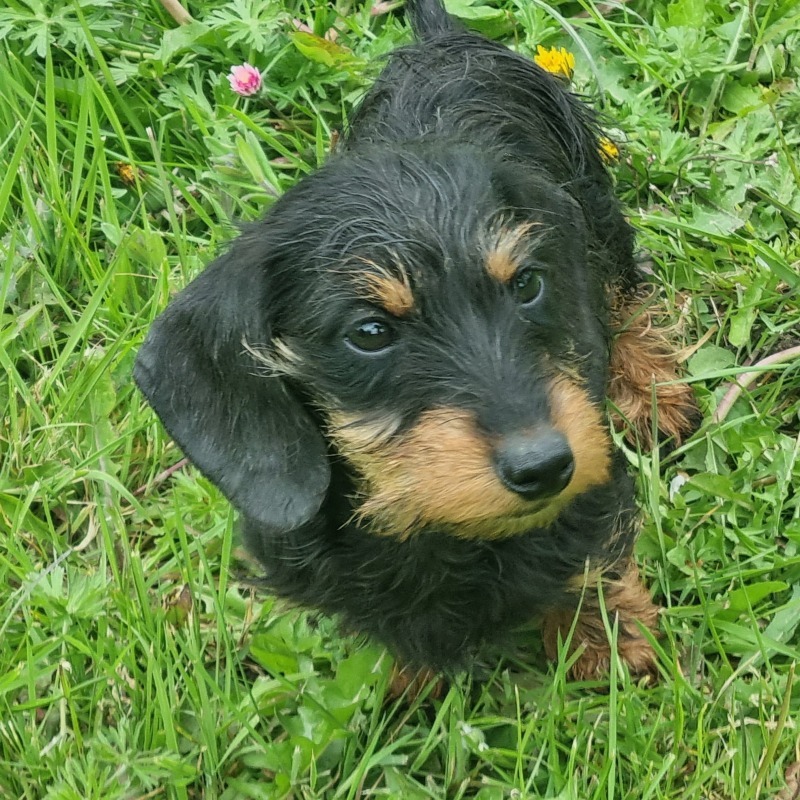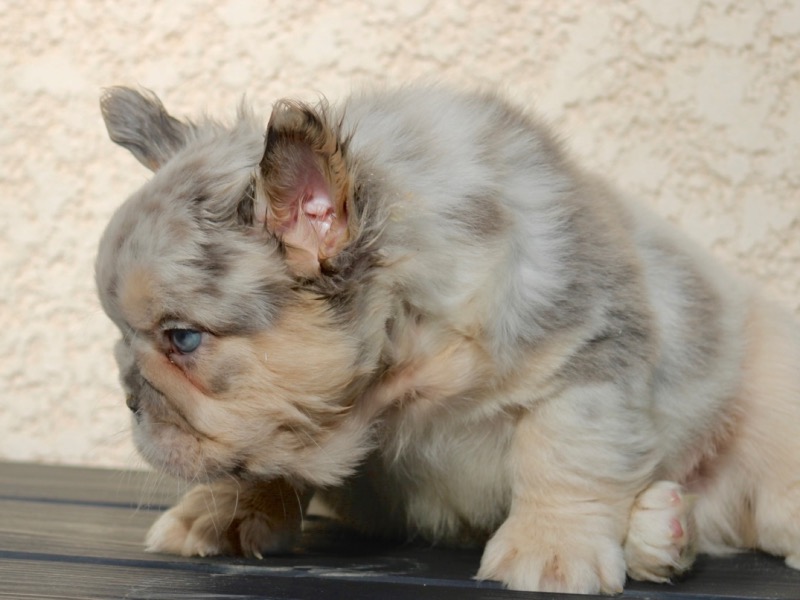Dachshund
Autres noms : Teckel
Discover the dachshund, a dog with a dynamic character and a unique appearance. With its elongated body and short legs, this endearing breed is known for its intelligence, loyalty, and cheerful temperament. Perfect for families and active owners!
Awareness of acquiring an animal
Adopting or breeding a dog is a responsibility that must be carefully considered. Dogs are loyal companions that require time, attention, and constant care. Whether for leisure, passion, or professional breeding, it is crucial to understand the specific needs of each breed. Provide them with a loving and stimulating environment, and avoid any impulsive acquisition that could harm their well-being. Be a vigilant and committed owner for a happy and healthy companion.
To learn more about animal welfare, we invite you to consult our FAQ by clicking the button below:
Origins and history
The dachshund has its origins in Europe, particularly in Germany, where it was developed in the 17th century. This dog was initially bred to hunt badgers and other burrowing animals due to its excellent sense of smell and digging ability. Its elongated body and short legs are physical traits that allow it to maneuver into burrows and track its prey.
Over time, the dachshund gained popularity, becoming valued not only for its hunting skills but also for its temperament. It is known to be courageous, intelligent, and sometimes a bit stubborn. These personality traits have made it a beloved companion in families, beyond its role as a hunting dog.
The dachshund comes in several sizes and coat types: smooth coat, long coat, and wire-haired. Each of these varieties has unique characteristics, yet they share a common foundation that makes the dachshund an affectionate and playful dog. Today, this breed is often chosen as a pet while still retaining a strong hunting instinct.
Physical characteristics
The Dachshund is a distinct dog breed, recognizable by its unique silhouette and particular stature. With an elongated body and short legs, it displays a striking balance between its proportions. Its weight generally ranges from 3 to 12 kg, depending on the chosen size, which can be standard or miniature. Dachshunds have an elongated head and a straight muzzle, creating a bright and curious expression.
Their long, floppy ears add to the charm of this breed, and they are often covered in silky fur, especially in long-haired Dachshunds. The eyes, oval in shape, are typically dark and exude a keen intelligence. Regarding their coat, there are three distinct types: smooth, long-haired, and wire-haired. Each type has specific characteristics, with the wire-haired coat being often rough to the touch, while the long-haired coat is softer and silkier.
The coat color varies significantly, ranging from black, chocolate, and red to brindle or dappled patterns. All of these physical characteristics make the Dachshund a dog that is both elegant and full of personality, appreciated for its liveliness and playful spirit.
Character
The Dachshund, with its elongated body and short legs, is a dog breed with a well-defined personality. This dog is often described as brave and determined. These traits stem from its history, as it was originally bred to hunt burrowing animals. Its fearless nature allows it to face challenges, whether they are physical or emotional.
Despite its small size, the Dachshund is very affectionate towards its family. It is loyal and protective, establishing a strong bond with its owners. This attachment can sometimes make it a bit jealous or possessive, but it reflects a sincere and profound love. This loyalty is also evident in its behavior towards strangers, where it may be reserved, yet protective if necessary.
The Dachshund's natural intelligence makes it a very curious and sometimes stubborn dog. It requires patient and consistent training to channel its energy and instincts. When well-trained, it is playful and happy, bringing joy and liveliness to its home. In summary, the personality of the Dachshund makes it a companion that is both endearing and demanding.
Life expectancy
The life expectancy of dachshunds typically ranges from 12 to 16 years, with variations depending on several factors. This breed, characterized by its long body and short legs, is known for its sturdiness and energy.
The general health of a dog significantly impacts its life expectancy. Dachshunds may be prone to certain hereditary diseases, particularly spinal issues such as disc herniation. Genetics, diet, exercise, and regular veterinary care all play a crucial role in an animal's well-being and can influence its longevity.
An active and balanced lifestyle contributes to overall health. Dachshunds require regular walks and activities suitable for their size to maintain their ideal weight and avoid health problems related to obesity. Additionally, frequent health check-ups can help detect potential health issues early on.
In conclusion, the life expectancy of dachshunds is relatively high for small breeds, but various considerations and appropriate care are essential to maximize their longevity.
Exercise and activity needs
Dachshunds, due to their size and unique morphology, have specific needs when it comes to exercise and activity. Although they are small, they are active, curious, and full of energy. An adult Dachshund needs about 30 to 60 minutes of daily exercise to stay healthy, both physically and mentally.
It is recommended to vary the types of activities. Regular walks, without being too intense, are ideal to satisfy their curiosity. However, these dogs also enjoy interactive games such as retrieving objects or agility sessions. Incorporating activities that stimulate their hunting instinct can be beneficial, like playing catch with a ball.
Additionally, Dachshunds have a strong need for mental stimulation. Interactive toys and obedience exercises can help them channel their energy constructively. Ensuring a balance between physical and mental exercise is essential to prevent boredom and destructive behaviors.
Recommended diet
The diet of dachshunds must be carefully planned to meet their specific needs, as this breed has physiological characteristics that influence their nutritional requirements. Due to their long bodies and vulnerable backs, it is crucial to maintain an ideal weight to prevent spinal problems. Excess weight can lead to pain and mobility issues.
It is recommended to choose high-quality food that is rich in proteins and essential nutrients. Foods formulated for small breeds are often appropriate, as they contain adequate levels of calories and nutrients. Animal-based proteins should be listed as the first ingredients, supporting muscle mass and providing the necessary energy for their daily activities.
It is also essential to divide their meals. Generally, two to three meals per day are recommended, avoiding overfeeding. Hydration is crucial as well; make sure your dog always has access to fresh water. Finally, it is advisable to avoid giving foods rich in fats or sugars, which could harm their health. Regular check-ups at the veterinarian will help adjust the diet according to the specific needs of each animal.
Training and obedience
Training and educating dachshunds requires a patient and tailored approach. Due to their often independent and curious temperament, it is crucial to start their training at a young age. Puppies are particularly receptive to learning, which allows for the establishment of a solid foundation of behavior and obedience.
It is advisable to use positive reinforcement methods, such as food rewards and verbal praise. This not only promotes learning but also strengthens the bond between the owner and the dog. Training sessions should be short but frequent to maintain the animal's attention and avoid boredom. Consistency is key; commands should always be given in the same way to prevent any confusion.
Socialization is also a crucial aspect for this breed. Dachshunds, who can be reserved towards strangers, should be exposed to various situations, people, and other dogs from a young age. This will help them gain confidence and adopt a balanced behavior. Additionally, it is essential to ensure they receive enough exercise and mental stimulation to channel their energy and hunting instincts.
Behavior with children
The Dachshund is a dog breed that generally exhibits a friendly and affectionate demeanor towards children. Their playful nature and energy make them ideal playmates for younger ones. They often have a lively temperament, which attracts children who enjoy their spirited antics. However, it is important to teach children to interact with these dogs in a respectful and calm manner to avoid any sudden behavior that might disturb the dog.
Despite their small size, Dachshunds are protective and can develop a strong bond with family members, including children. They are often very loyal and emotionally invested in their relationships. Nonetheless, this loyalty can sometimes manifest as a wary attitude towards strangers, which necessitates early socialization to prevent excessive protective behavior.
It is also important to consider their independent character. They need moments of solitude and may want to make their own choices. Therefore, it is crucial to teach children to give the dog space when it needs it. Additionally, proper supervision of interactions between the Dachshund and children is essential to create a harmonious and safe environment. In summary, with appropriate training and adequate supervision, Dachshunds can happily coexist with children, bringing joy and affection to the family.
Compatibility with Other Animals
The Dachshund is a dog breed that can adapt to family life and coexist with other pets, but its compatibility depends on several factors, including its temperament, socialization, and training. Generally, these dogs have a strong hunting instinct due to their history as weasel-hunting dogs. This can influence their behavior towards other animals, especially small ones like rodents or birds.
Early socialization is crucial for fostering good coexistence. Exposing a Dachshund to different types of animals from a young age can help it develop friendly behaviors. Positive interactions with other animals under supervision encourage peaceful behavior and reduce the risk of aggression. It is essential to introduce new animals gradually, carefully monitoring the reactions of both parties.
Finally, individual personality plays an important role. Some Dachshunds may be more dominant or territorial, which can make interactions with other animals more complicated. In summary, with proper socialization, adequate training, and careful introductions, a Dachshund can coexist well with other pets, but special attention must be given to each situation.
Grooming needs
Dachshunds, with their varied coats, require specific care based on their fur type: smooth, long-haired, or wiry. Each coat type necessitates special attention to maintain the dog's hygiene and health. Smooth-haired dachshunds have simpler maintenance requirements, with regular brushing to remove dead hair and keep the skin healthy. Occasional bathing is sufficient for their coat, as excessive washing can lead to skin irritations.
Long-haired dachshunds require frequent brushing, ideally two to three times a week, to prevent knots and tangles. Professional grooming may be considered every two to three months to keep their coat in optimal condition. Wired-haired dachshunds, on the other hand, need less frequent brushing, but regular maintenance is crucial to preserve the characteristic texture of their fur.
Beyond coat care, it is essential to pay attention to the dachshund's ears, nails, and teeth. Ears should be checked regularly and cleaned if necessary to prevent infections. Nails should be trimmed to avoid discomfort and locomotion issues. Finally, regular dental brushing is recommended to prevent dental problems. Overall and consistent care contributes to the health and well-being of this endearing breed.
Health
Dachshunds are highly appreciated dogs, but their health can be subject to various concerns due to their unique morphology. Their elongated bodies and short legs predispose them to spinal issues, such as intervertebral disc disease. This condition, which leads to chronic pain and difficulties in movement, is particularly common in this breed.
In addition to back problems, dachshunds can also suffer from hip dysplasia, a malformation of the joint that can cause pain and reduce the animal's quality of life. Excessive weight exacerbates this type of problem, so it is essential to maintain a balanced diet and regular exercise.
Dental issues are also common in this breed. Dachshunds tend to accumulate tartar, which can lead to periodontal diseases. Regular dental care, such as brushing their teeth, is recommended to prevent these problems.
Finally, it is crucial to have regular veterinary visits. This allows for the early detection of potential health issues and ensures appropriate follow-up, thus guaranteeing a long and healthy life for the dachshund.
Environment and habitat
The dachshund is a breed of dog characterized by its elongated body and short legs. Originally bred for hunting foxes and badgers, this dog has adapted to various environments while retaining a strong instinct to dig. Although they can acclimate to urban settings, these animals benefit from a stimulating environment, such as an outdoor space where they can expend energy.
In terms of habitat, the dachshund thrives in a setting where it can explore and engage in physical activities. A fenced garden is ideal to allow this curious dog to play safely. Early socialization is also crucial, promoting interactions with other animals and humans. In an apartment, it is essential to ensure sufficient daily exercise, as these dogs can develop destructive behaviors if they get bored.
In summary, the breed flourishes in a stimulating environment, whether in rural or urban areas, as long as its exercise and interaction needs are met.
Name ideas
Choosing a name for a dachshund is a task that deserves special attention. First of all, it's important to select a name that is short and easy to pronounce, ideally consisting of one or two syllables. This will facilitate the dog's learning of the name and make calling more effective. Next, taking into account your dachshund's personality and appearance can also guide your choice. A name that reflects its character traits or physical characteristics can strengthen the bond between you and your companion.
Also, consider avoiding names that sound like common commands, such as "Sit" or "No," to prevent any confusion. Additionally, think about cultural references, characters from movies or books that inspire you. This could add a personal and fun touch to your daily life.
Here are some name suggestions for a dachshund: Ziggy, Nala, Choco, Bella, Duffy, Moka, OLLIE, Kiwi, Trixie, Gigi, Pépito, Loulou, Timon, Pluto, and Leo. These names are easy to pronounce and can suit the unique personality of your dog.
Average purchase price
The price of a purebred dog can vary significantly depending on several factors. For dachshunds, prices generally range between €500 and €2000. This range primarily depends on the reputation of the breeder, the genetics of the animal, and its pedigree. Dogs from champion lines or with parents who have had successes in competitions can be sold at higher prices.
Another aspect to consider is geographical location. Prices may be higher in urban areas, where demand is often greater. Additionally, the year of birth, size (standard, miniature, or kaninchen), and coat color can also influence the cost. Dachshunds with rarer colors or particular patterns can achieve higher prices due to their rarity.
Finally, it is crucial to inquire about breeding practices. A responsible breeder who conducts health tests on their animals may charge more but also ensures better quality and well-being for the dog. It is always recommended to do thorough research and turn to reputable breeders to ensure a good investment.
Expenses
Owning a Dachshund involves a number of monthly expenses that are important to consider. On average, the costs related to food amount to about 30 to 50 euros. This amount varies depending on the quality of the kibble chosen and the specific nutritional needs of the animal.
Next, veterinary care costs represent another significant expense. Including vaccinations, routine check-ups, and possibly antiparasitic treatments, expect to budget around 20 to 40 euros per month. It’s essential to ensure that the animal remains in good health throughout its life.
Other costs to consider include accessories such as collars, leashes, and toys. For these items, a budget of around 10 to 20 euros per month can be reasonable. Additionally, if you choose to use a pet-sitting service or a dog walker, this can add an extra 50 to 150 euros, depending on the frequency and duration of the services.
In summary, a Dachshund owner can expect monthly expenses ranging from 150 to 300 euros, taking into account food, veterinary care, and accessories, not to mention additional services.
Destination and usage
Dachshunds, with their distinctive silhouette and friendly temperament, have become popular companions in many households. Their small size makes them ideal pets for urban dwellers, easily adapting to apartment living. Their affectionate temperament and curious nature make them endearing companions. They become deeply attached to their owners, often seeking closeness and interaction.
Their intelligence and playful personality allow them to integrate into various family situations. Whether it's during walks in the park, playing at home, or interacting with children, dachshunds bring joy and energy. They are also alert and protective, making them good guardians while remaining sociable with visitors.
When it comes to training, these dogs can sometimes present challenges due to their independent nature, but with patience and positive methods, they can learn a variety of commands and tricks. Thanks to their uniqueness, dachshunds remain a preferred breed for those seeking a loyal and cheerful companion in everyday life.
Legislation and regulation
Legislation and regulations regarding dachshunds vary significantly from country to country. In some regions, these dogs are considered popular pets and are subject to standard regulations on breeding and ownership. Owners often have to comply with general animal welfare laws, which include requirements regarding health and living conditions.
In other countries, specific laws may be implemented due to safety concerns. While dachshunds are generally not classified as dangerous dogs, there may be restrictions on the number of animals a person can own or on areas where they are allowed to walk them. Some countries also require that all dogs be registered, and vaccination requirements may apply.
At the same time, animal protection organizations in several nations advocate for responsible breeding practices. Animal welfare is often at the heart of the discussions, and laws may be enacted to prohibit irresponsible breeding for commercial purposes. Awareness campaigns aim to educate owners about the specific needs of these dogs, encouraging proper care practices.
Official recognition
The Dachshund, a hunting dog with German origins, is widely recognized in many countries around the world. In Europe, particularly in France, the United Kingdom, and Germany, this breed is accepted by leading kennel clubs such as the Société centrale canine and the Kennel Club. These organizations regulate the breed standards, ensuring genetic integrity and adherence to morphological characteristics.
In North America, the Dachshund is also recognized by the American Kennel Club, which organizes specific shows and competitions for this breed. American owners appreciate not only its size and temperament but also its diversity in variations, both in coat types and colors.
In other regions of the world, such as Japan and Australia, the Dachshund is popular and respected in dog competitions. Breeders strive to maintain the quality of the breed while adhering to the standards set by local and international organizations. This consensus around the recognition of the Dachshund reflects the affection that people have for this breed across different cultures.
Pedigrees
To obtain a pedigree for Dachshunds, several clubs and registries are in place at both the international and national levels. Each country typically has its own organization responsible for managing the registrations of dog breeds, including the Dachshund. These organizations ensure compliance with breed standards and the preservation of bloodlines.
In France, the Société Centrale Canine is the main authority for the registration of purebred dogs. It issues pedigrees that attest to the purity of the breed and the ancestry of the animals. In collaboration with breed clubs such as the Dachshund Breed Club, these organizations organize events, such as shows, where Dachshunds can be judged.
Abroad, other national registries, such as the Kennel Club in the UK or the American Kennel Club in the United States, offer similar services. Breeders must register their litters and provide the necessary information to obtain pedigrees. These documents are crucial for breeders, as they ensure traceability and the health of the dogs and help maintain high breed standards worldwide.
Prohibitions
The regulations concerning this breed of dogs vary significantly from country to country. In some states, there are strict rules related to the ownership of certain dog breeds, often due to concerns about aggression or public safety. However, dachshunds are generally not among the most commonly banned breeds. That said, restrictions may exist in specific areas, especially if incidents involving these dogs are reported.
Some local legislations impose limits on the size or behavior of the breed. In several European countries, regulations may require sterilizations, special licenses, or liability insurance. These measures aim to ensure public safety while recognizing the playful and affectionate nature of these animals.
Dachshund owners should also be aware of regulations concerning breeding and sales. Animal welfare organizations advocate for ethical practices, which can limit unregulated breeding. In summary, although this breed is generally well-accepted from a legislative standpoint, owners should educate themselves about local laws to avoid complications.
Breeders of Dachshund
Want to see more breeders of Dachshund?
Check out the page of our directory listing all breeders of DachshundClassified Ads of Dachshund
Breed clubs of dachshund
No of dachshund breed clubs are currently registered on Preeders.
If you would like to highlight your breed club, sign up for free now and be the first to appear on this page.







